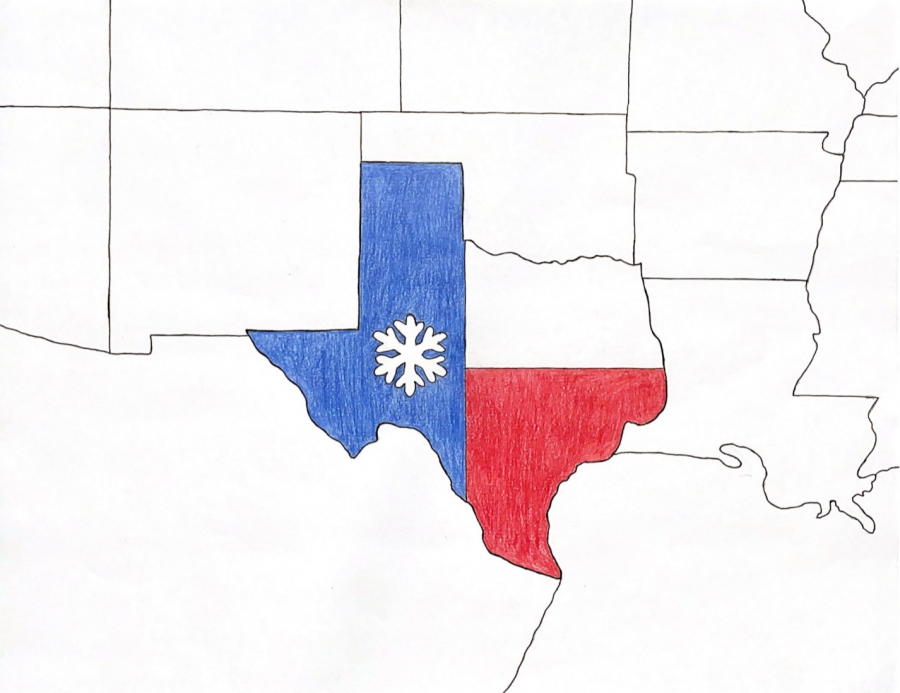Climate experts warn states to be proactive in fatal aftermath of Texas winter storm
May 8, 2021
A winter storm battered Texas in February, leaving many residents with no water or electricity. Scientists attributed the natural disaster to climate change and are devising ways to prevent another deadly one in the state.
During the week of February 13-17, Texas’ record–low temperatures and increasing snow totals forced schools to close their doors, and the state’s power grids began to shut down.
Millions were left without heat and clean water also became scarce, and many were unable to boil water without power in their homes. The situation grew so dire that people fled to grocery stores not just to stock up on supplies, but for warmth as well.
“During the storm, at least 4.5 million electricity customers in Texas lost power, an estimated 57 people died due to hypothermia, and about 12 million people received ‘boil notices’ because of water quality issues,” according to PBS. Months later, the death toll from the winter storm continues to grow, with 151 dead as of April 30. Causes of death ranged from hypothermia to exacerbation of preexisting health conditions.
Worst of all, the storm brought the deadliest carbon monoxide poisoning crisis in recent history, according to ProPublica.
In order to warm up during the storms, many Texans sought refuge in their running cars in garages attached to their homes. Car fumes spread into homes, and since carbon monoxide detectors aren’t required in Texas, people continued breathing in the poisoned air for weeks after the storms.
“So we have a water problem—freezing water, become a gas problem, become a power problem, become a bigger gas problem, become a bigger power problem, become a water problem and a humanitarian crisis,” Michael Webber, an energy resources professor at the University of Texas at Austin, said.
The storm and its fallout, however, could be a part of a larger issue — climate change.
The director of the Atmospheric Studies Program at the University of Georgia, James Marshall Shepherd, explained that the weather patterns in Texas can be attributed to a common phenomenon: the polar vortex.
“Typically, it’s sort of keeping that cold air up in the Arctic. But occasionally it can be breached or weakened, and you get these disruptions in the polar vortex. And then you can get this cold, dense air to ooze down into the lower 48. That’s what we’re seeing,” Shepherd said.
Although climate change could cause these weather disruptions to happen more often, Shepherd said it would be “sort of scientifically irresponsible” to directly link climate change to the storms. “But we know that there may be a connection going forward with these types of events,” he explained.
Since the February storm, Texas has endured another cold anomaly. Recently in late April, softball-sized hail rained down, destroying car windows and damaging homes. Some areas reported the three to four-inch ice even broke through sheet rock.
“The hail damage yesterday could become yet another billion-dollar weather disaster for the U.S.,” CNN senior meteorologist Dave Hennen said. “This could be the second billion-dollar disaster this year in Texas, after the extreme Arctic outbreak back in February.”
Hence, scientists and climate experts are putting emphasis on preparing for future extreme weather events.
The Electric Reliability Council of Texas was accused of not listening to warnings to adapt their power grid systems to make them suitable for harsh winters after a similar weather incident in 2011. Had the advice been heeded then, the weather fiasco in February, which was caused by power failure, would likely not have happened or been as severe.
There is time for ERCOT to winterize its grid, but it needs to act now, considering that climate change will only breed worse issues for Texas, like hurricanes and agricultural issues.
The tools and materials to implement these changes have been widely available for years, however. For instance, the U.S. Department of Energy and others have published guides telling electric utilities and grid operators how to plan effectively for the impacts of climate change, according to The Hill.
Still, these operators choose not to make changes, as is the case with Texas.
These old systems, however, reliant on natural gas or coal, are no longer sufficient enough to fuel cities or states if they are not updated to handle different types of weather, whether it be scalding hot temperatures or bitterly freezing ones.
“Climate change means that the weather patterns of the past are not adequate to inform those of the future,” Former Energy Secretary Ernest Moniz said at a hearing hosted by the House Energy and Commerce Committee.
Texas is a case study of what can happen when a state refuses to adapt to climate change and cautiously act against it.








